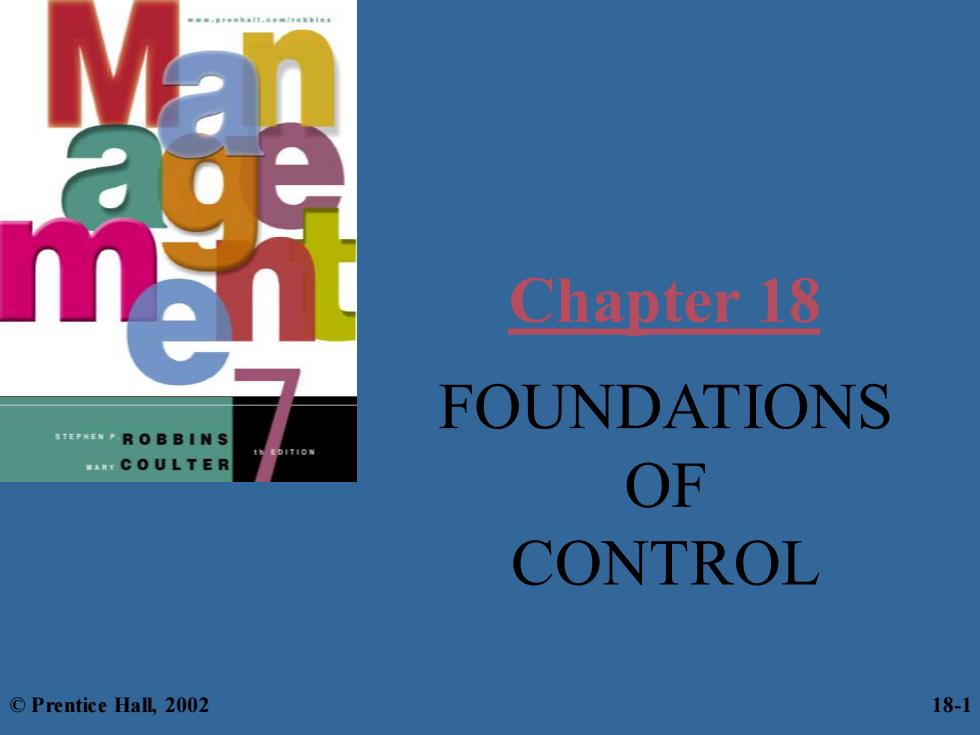
Chapter 18 FOUNDATIONS DROB BI NS ACOULTER OF CONTROL ©Prentice Hall,2002 18-1
Chapter 18 FOUNDATIONS OF CONTROL © Prentice Hall, 2002 18-1
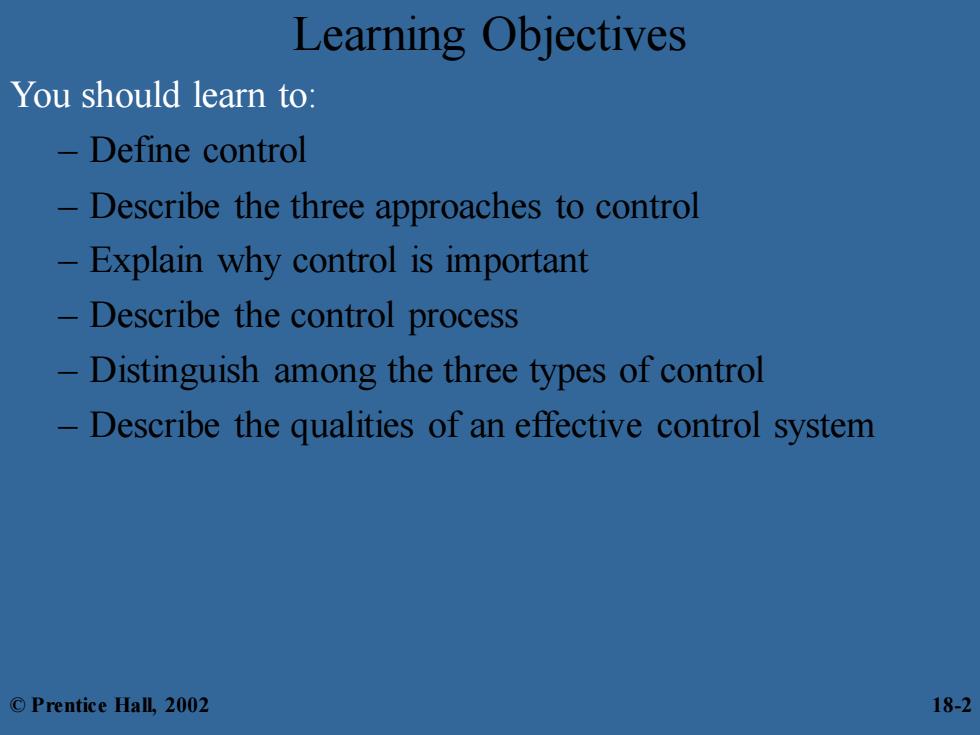
Learning Objectives You should learn to: Define control Describe the three approaches to control Explain why control is important Describe the control process Distinguish among the three types of control -Describe the qualities of an effective control system ©Prentice Hall,2002 18-2
Learning Objectives You should learn to: – Define control – Describe the three approaches to control – Explain why control is important – Describe the control process – Distinguish among the three types of control – Describe the qualities of an effective control system © Prentice Hall, 2002 18-2
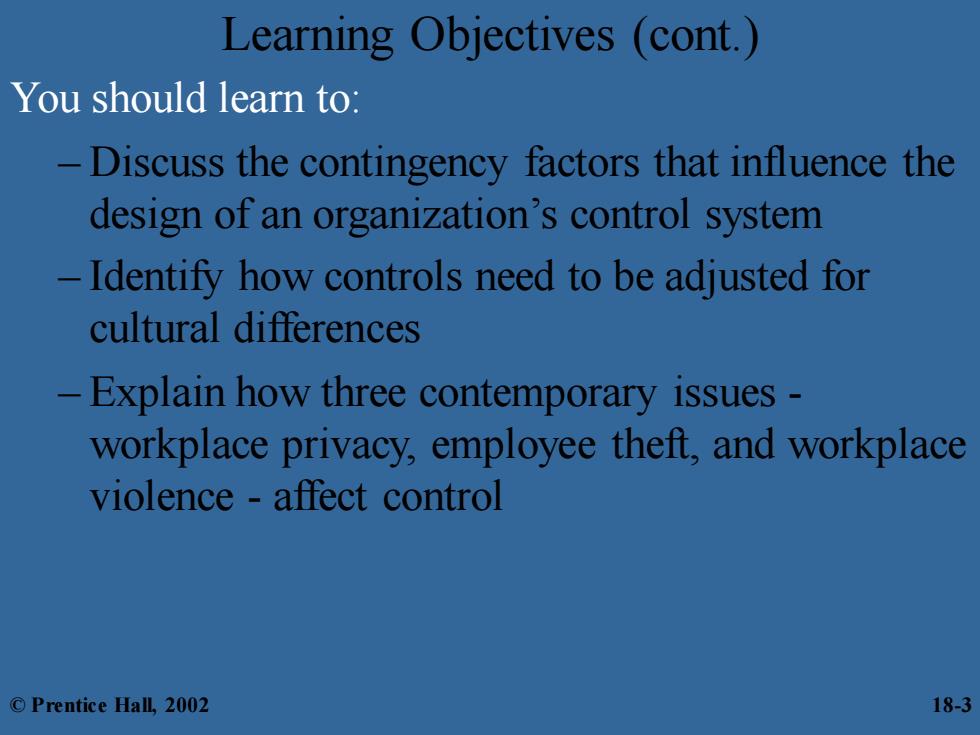
Learning Objectives (cont. You should learn to: Discuss the contingency factors that influence the design of an organization's control system Identify how controls need to be adjusted for cultural differences Explain how three contemporary issues workplace privacy,employee theft,and workplace violence affect control ©Prentice Hall,2002 18-3
Learning Objectives (cont.) You should learn to: – Discuss the contingency factors that influence the design of an organization’s control system – Identify how controls need to be adjusted for cultural differences – Explain how three contemporary issues - workplace privacy, employee theft, and workplace violence - affect control © Prentice Hall, 2002 18-3
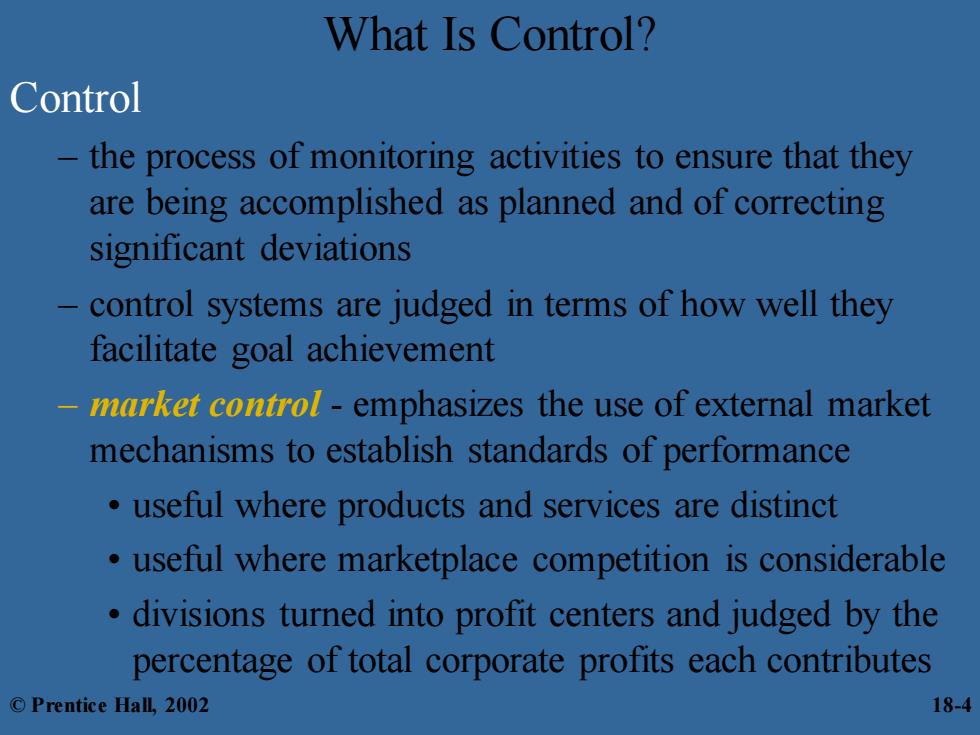
What Is Control? Control -the process of monitoring activities to ensure that they are being accomplished as planned and of correcting significant deviations control systems are judged in terms of how well they facilitate goal achievement marker control-emphasizes the use of external market mechanisms to establish standards of performance useful where products and services are distinct useful where marketplace competition is considerable divisions turned into profit centers and judged by the percentage of total corporate profits each contributes ©Prentice Hall,2002 18-4
What Is Control? Control – the process of monitoring activities to ensure that they are being accomplished as planned and of correcting significant deviations – control systems are judged in terms of how well they facilitate goal achievement – market control - emphasizes the use of external market mechanisms to establish standards of performance • useful where products and services are distinct • useful where marketplace competition is considerable • divisions turned into profit centers and judged by the percentage of total corporate profits each contributes © Prentice Hall, 2002 18-4
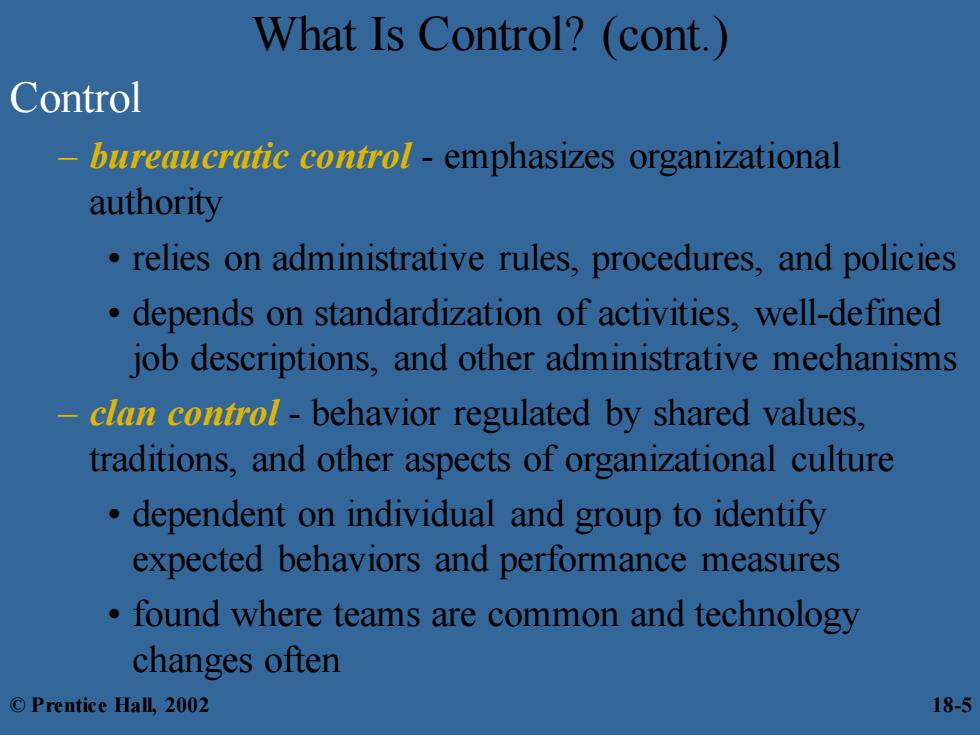
What Is Control?(cont. Control bureauerutic control emphasizes organizational authority relies on administrative rules,procedures,and policies depends on standardization of activities,well-defined job descriptions,and other administrative mechanisms -clan controll-behavior regulated by shared values, traditions,and other aspects of organizational culture dependent on individual and group to identify expected behaviors and performance measures found where teams are common and technology changes often ©Prentice Hall,2002 18-5
What Is Control? (cont.) Control – bureaucratic control - emphasizes organizational authority • relies on administrative rules, procedures, and policies • depends on standardization of activities, well-defined job descriptions, and other administrative mechanisms – clan control - behavior regulated by shared values, traditions, and other aspects of organizational culture • dependent on individual and group to identify expected behaviors and performance measures • found where teams are common and technology changes often © Prentice Hall, 2002 18-5
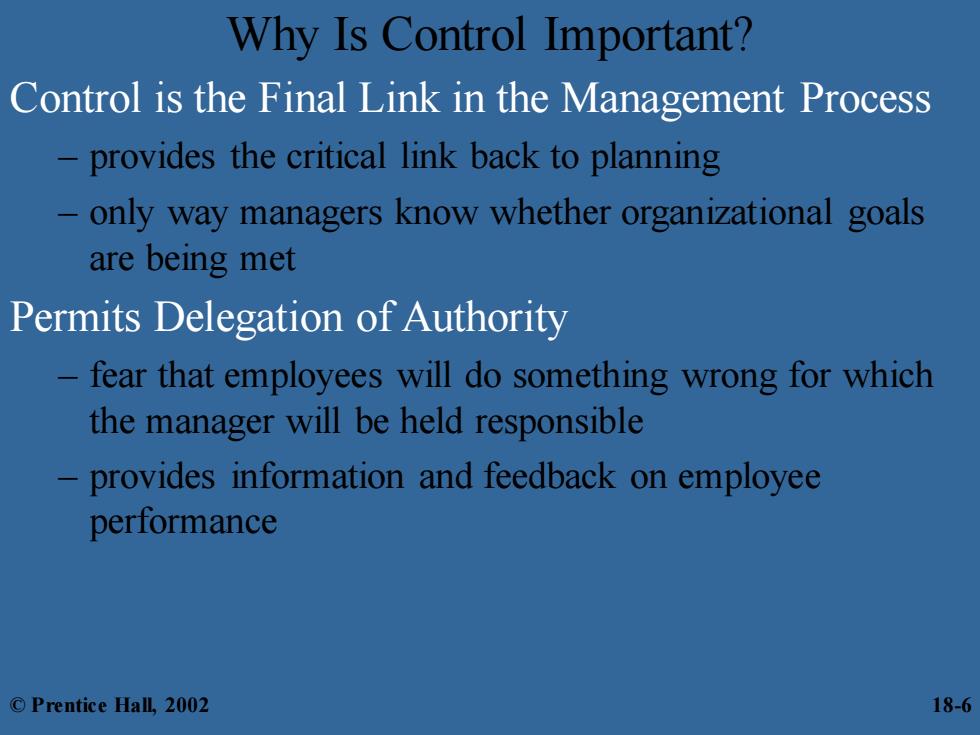
Why Is Control Important? Control is the Final Link in the Management Process provides the critical link back to planning only way managers know whether organizational goals are being met Permits Delegation of Authority fear that employees will do something wrong for which the manager will be held responsible provides information and feedback on employee performance ©Prentice Hall,2002 18-6
Why Is Control Important? Control is the Final Link in the Management Process – provides the critical link back to planning – only way managers know whether organizational goals are being met Permits Delegation of Authority – fear that employees will do something wrong for which the manager will be held responsible – provides information and feedback on employee performance © Prentice Hall, 2002 18-6
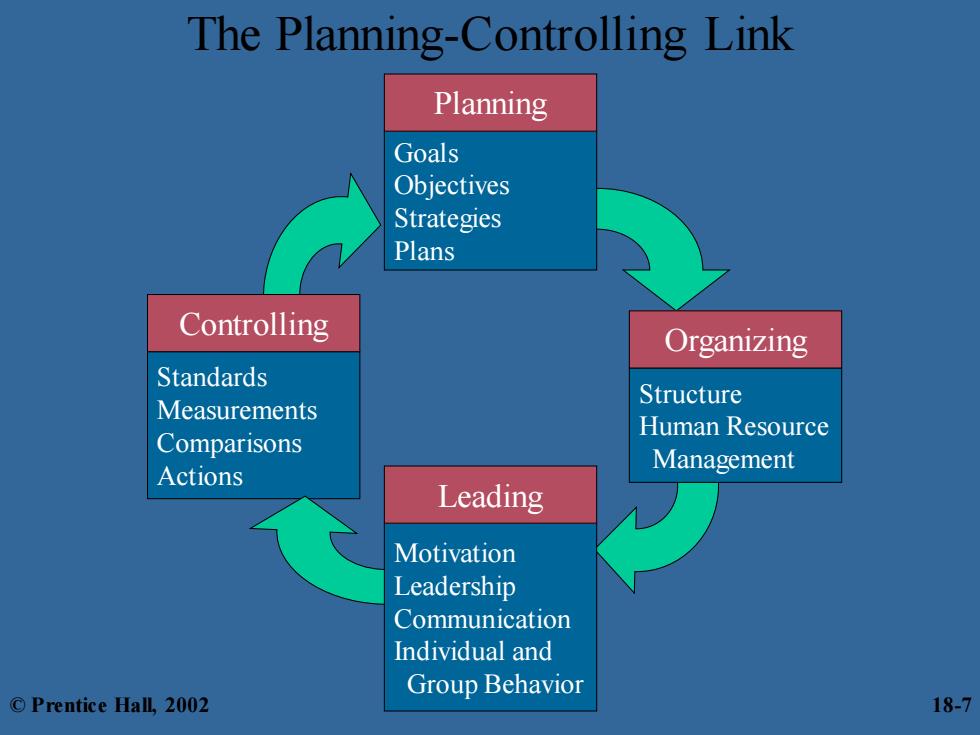
The Planning-Controlling Link Planning Goals Objectives Strategies Plans Controlling Organizing Standards Structure Measurements Human Resource Comparisons Management Actions Leading Motivation Leadership Communication Individual and Group Behavior ©Prentice Hall,2002 18-7
Structure Human Resource Management Organizing The Planning-Controlling Link Standards Measurements Comparisons Actions Controlling Goals Objectives Strategies Plans Planning Motivation Leadership Communication Individual and Group Behavior Leading © Prentice Hall, 2002 18-7

The Control Process Step 1. Measuring Actual Performance GOALS AND OBJECTIVES Comparing Actual Organizational Performance Step 2. Divisional Against Standard Departmental Individual Step 3. Taking Managerial Action ©Prentice Hall,2002 18-8
The Control Process © Prentice Hall, 2002 18-8
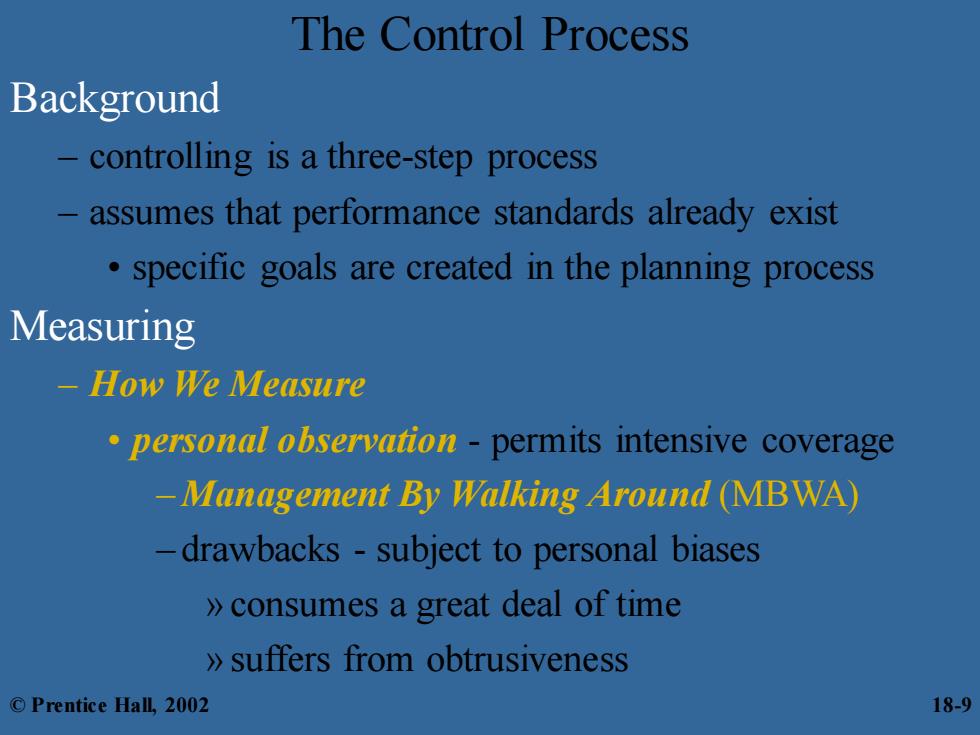
The Control Process Background controlling is a three-step process assumes that performance standards already exist specific goals are created in the planning process Measuring How We Measure personal observation permits intensive coverage -Management By Walking Around (MBWA) drawbacks -subject to personal biases >consumes a great deal of time >suffers from obtrusiveness ©Prentice Hall,2002 18-9
The Control Process Background – controlling is a three-step process – assumes that performance standards already exist • specific goals are created in the planning process Measuring – How We Measure • personal observation - permits intensive coverage –Management By Walking Around (MBWA) – drawbacks - subject to personal biases »consumes a great deal of time »suffers from obtrusiveness © Prentice Hall, 2002 18-9
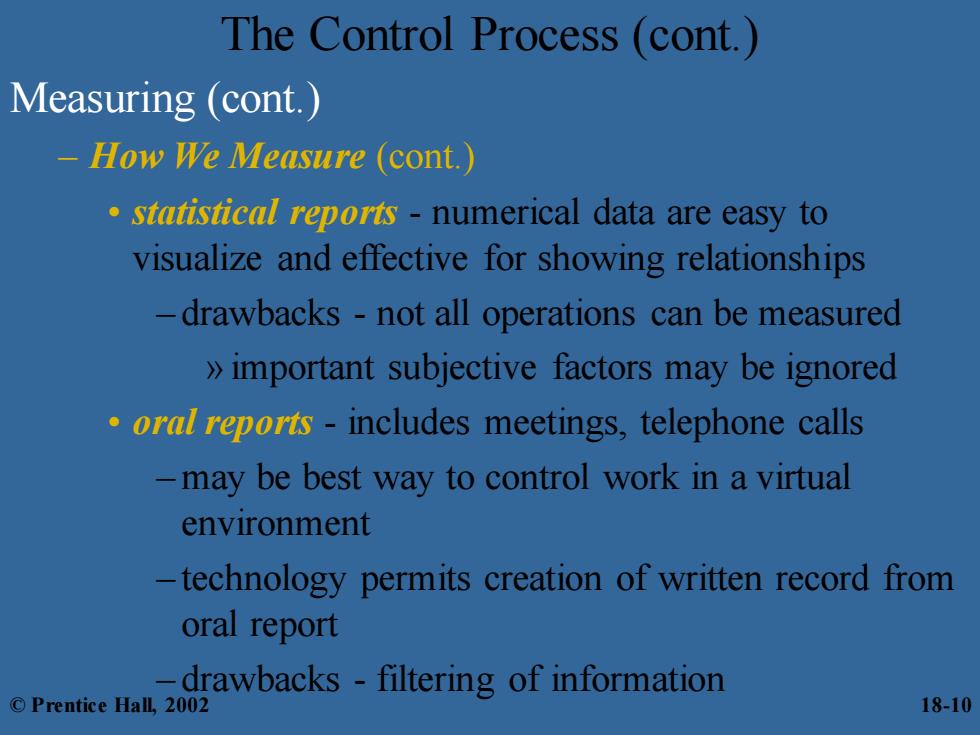
The Control Process(cont. Measuring (cont.) -How We Measure (cont.) statisticall reporis-numerical data are easy to visualize and effective for showing relationships -drawbacks-not all operations can be measured >important subjective factors may be ignored orall reporis-includes meetings,telephone calls -may be best way to control work in a virtual environment - technology permits creation of written record from oral report drawbacks-filtering of information ©Prentice Hall,2002 18-10
The Control Process (cont.) Measuring (cont.) – How We Measure (cont.) • statistical reports - numerical data are easy to visualize and effective for showing relationships – drawbacks - not all operations can be measured »important subjective factors may be ignored • oral reports - includes meetings, telephone calls –may be best way to control work in a virtual environment – technology permits creation of written record from oral report – drawbacks - filtering of information © Prentice Hall, 2002 18-10